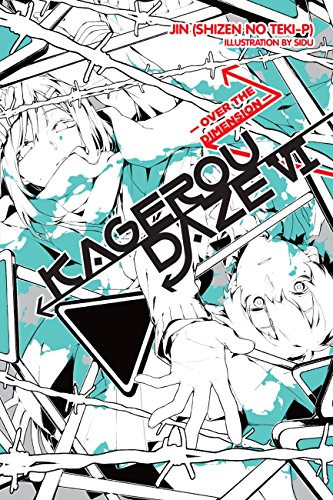By Jin (Shinzen no Teki-P) and Sidu. Released in Japan by Enterbrain. Released in North America by Yen On. Translated by Kevin Gifford.
(This review gets even more spoilery than I normally do, FYI.)
I will admit, those who are only familiar with Kagerou Daze via the light novels themselves, rather than the franchise in general, may be a little dissatisfied with the ending. It’s not really that the villains win or even that most of the cast die, it’s that it all ends with a big old reset button. We tried a cool plan, it didn’t work, and so we’re going back to try something else – which, it turns out, they’ve been doing for a long, long time. Kagerou Daze is not a visual novel, but like Higurashi and Little Busters, it revolves around repeating a sequence of time to try and fix things. In the case of the light novel, things don’t get fixed. Oh, there are some survivors – the “side story” in this book deals with Seto and Marie after everything else has already happened, and Hibiya is still around as well – but no one really wins. Not even the villains.
That said, the novels are not all there is to Kagerou Daze. The books are based on a series of songs, and the final song in the “main” series, Summer Time Reload, is also the title of this book. It implies the majority of the cast survive, though they may forget about all this. There’s also the manga, which is just about to wrap up in Japan, and clearly tells a different version of events from the books and the songs. And there’s also the anime, Mekakucity Actors, which may annoy fans for various reasons, but also arguably provides the most closure. All the spinoffs are different kinds of flavoring to the main plot. Here, with prose, we get a lot of monologues showing off the emotional state of the cast – in fact, I would argue that Jin is better at this than he is at actual plotting.
There’s also an awful lot of shipping in this last volume, which surprised me. Kagerou Daze has a large shipping fandom – it’s got about 2.5K fics on Fanfiction.net – both het and otherwise. You don’t see much of the otherwise here, but other shippers should be pleased. Haruka clearly ships Shintaro and Ayano, and is visibly upset when their reunion in the Daze is less about “Sorry I forgot to say I love you before you killed yourself” and more “how do we stop the villains”. Hiyori, who I suspect the majority of readers may have forgotten about, pops in at the end too, and she’s just as tsundere as ever, though she does manage to spit out words very few tsunderes ever have. And the entire book is about Seto and Marry’s relationship, and how they’re family but also clearly want to have more, at least on his side. Sadly, his desire to protect is sort of destroying anything else they might have.
Jin’s afterword is very self-deprecatory, and I get that. These aren’t the best written books, especially in translation – there were several times when I could have used a “this character is now our narrator” slug at the top of the section. And Seto really did get the least focus of any character, coming off as a bit wet in the process. That said, in terms of emotion and character, Kagerou Daze was a fast favorite for me. The books make me want to listen to the songs, read the manga, and watch the anime all in a marathon. Which is all you can ask from a franchise spinoff.





